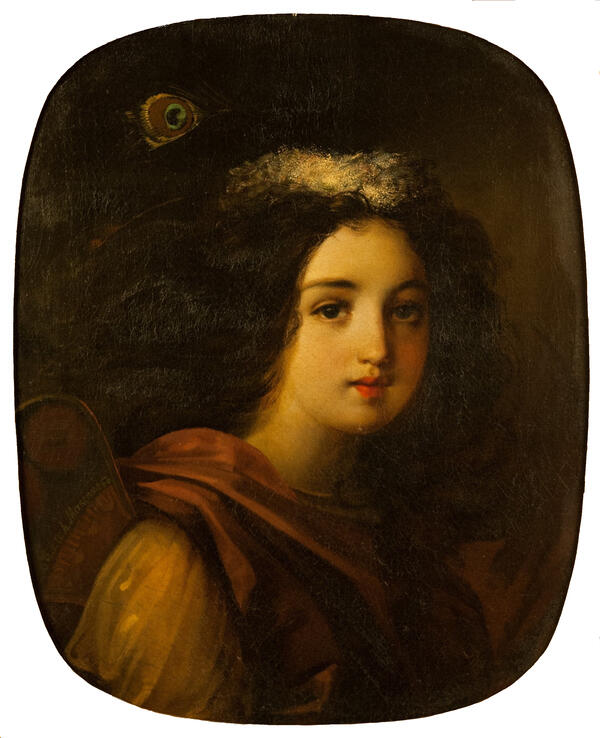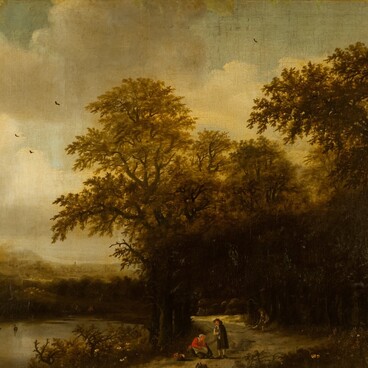Alexei Maximov (1810–1865) audited the classes of the Imperial Academy of Arts when he was twenty. Among his tutors was the great Karl Bryullov. In 1835 Maximov graduated with a Small Silver medal and achieved the rank of a Free Artist in 1836. His portrait painting earned him the promotion to an Academician in 1847, his greatest lifetime award.
‘Psyche’ was painted in 1845. ‘Psyche’ is the Greek for ‘soul’ or ‘breath’. The canvas arrived to Alupka museum-preserve from Kyiv museum of Russian art in 1956.
The composition is quite simple: it is a shoulder-length portrait of a young girl. Her gentle face is framed by the locks of her thick black hair, her dark eyes looking amiably at the viewer. Artistically, the picture is built on light and shadow contrast, as the girl’s brightly lit face is juxtaposed against the dark background.
The Ancient Greeks believed that, when a person dies, the soul leaves the body in the form of a butterfly. Later, it was Psyche who became the symbol of an immortal soul.
There are many versions of the Psyche myth, but the best-known one is probably the version by Apuleius that he described in his “Metamorphoses”. According to Apuleius, Psyche was so beautiful that she rivaled Venus, the goddess of love of beauty (Aphrodite in Greek mythology). Venus was insulted by it and decided to work her revenge on Psyche. She sent her son Cupid (Greek Eros) to shoot Psyche, but instead they fall in love with each other but soon were separated. Furious, Venus gave Psyche some impossible tasks. If she could complete them, she would be united with Cupid once more. When Psyche finally completed all the trials, Jupiter (Greek Zeus) gave her immortality so the couple could be united in marriage as equals.
The story of Psyche and her trials in the name of love has been a great inspiration for generations of artists, sculptors and writers. It was interpreted by Raphael Sanzio, Pieter Paul Rubens, Anthony van Dyke, Antonio Canova, Auguste Rodin, Edward Munch, François Gerard.
‘Psyche’ was painted in 1845. ‘Psyche’ is the Greek for ‘soul’ or ‘breath’. The canvas arrived to Alupka museum-preserve from Kyiv museum of Russian art in 1956.
The composition is quite simple: it is a shoulder-length portrait of a young girl. Her gentle face is framed by the locks of her thick black hair, her dark eyes looking amiably at the viewer. Artistically, the picture is built on light and shadow contrast, as the girl’s brightly lit face is juxtaposed against the dark background.
The Ancient Greeks believed that, when a person dies, the soul leaves the body in the form of a butterfly. Later, it was Psyche who became the symbol of an immortal soul.
There are many versions of the Psyche myth, but the best-known one is probably the version by Apuleius that he described in his “Metamorphoses”. According to Apuleius, Psyche was so beautiful that she rivaled Venus, the goddess of love of beauty (Aphrodite in Greek mythology). Venus was insulted by it and decided to work her revenge on Psyche. She sent her son Cupid (Greek Eros) to shoot Psyche, but instead they fall in love with each other but soon were separated. Furious, Venus gave Psyche some impossible tasks. If she could complete them, she would be united with Cupid once more. When Psyche finally completed all the trials, Jupiter (Greek Zeus) gave her immortality so the couple could be united in marriage as equals.
The story of Psyche and her trials in the name of love has been a great inspiration for generations of artists, sculptors and writers. It was interpreted by Raphael Sanzio, Pieter Paul Rubens, Anthony van Dyke, Antonio Canova, Auguste Rodin, Edward Munch, François Gerard.



